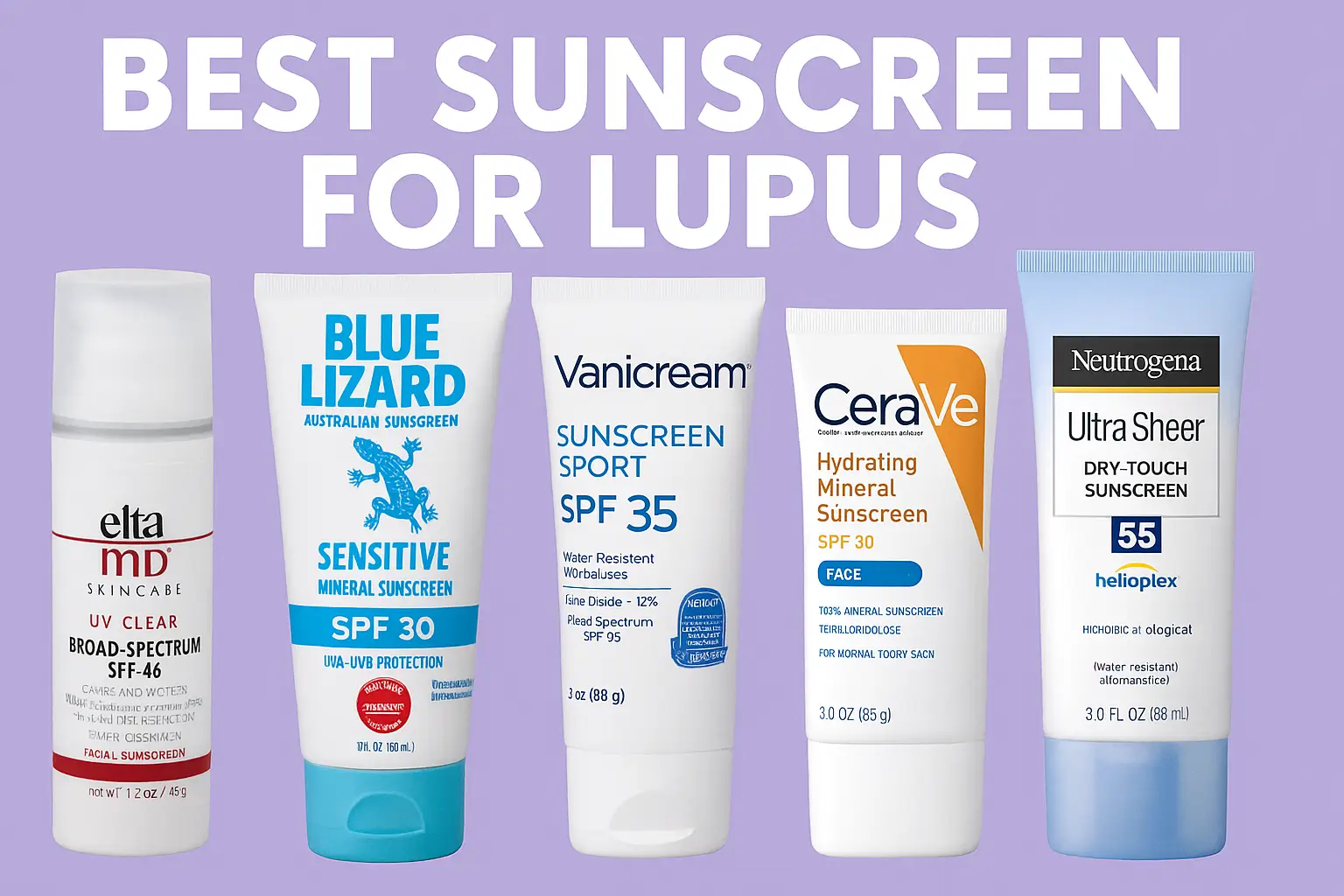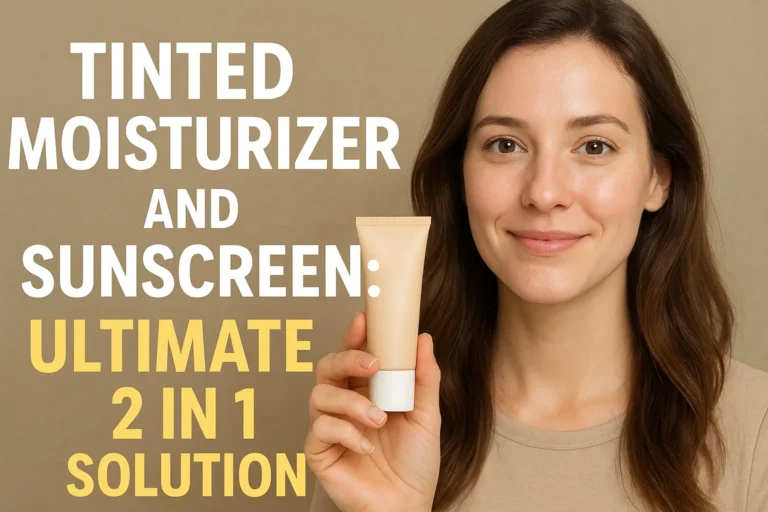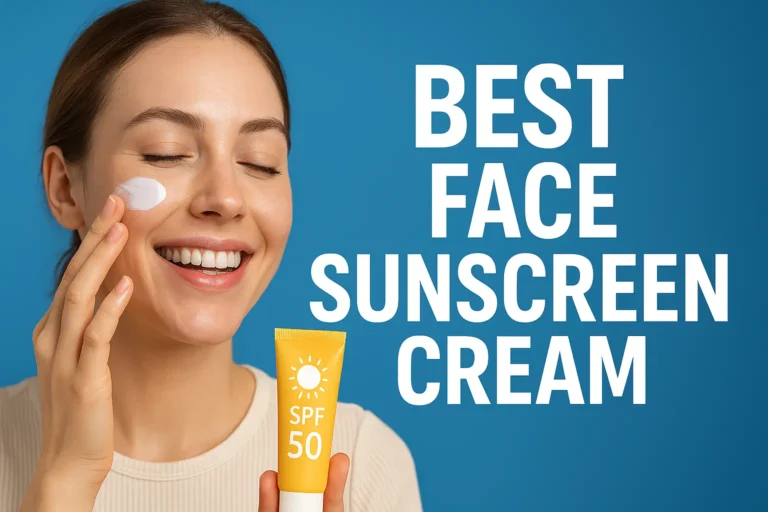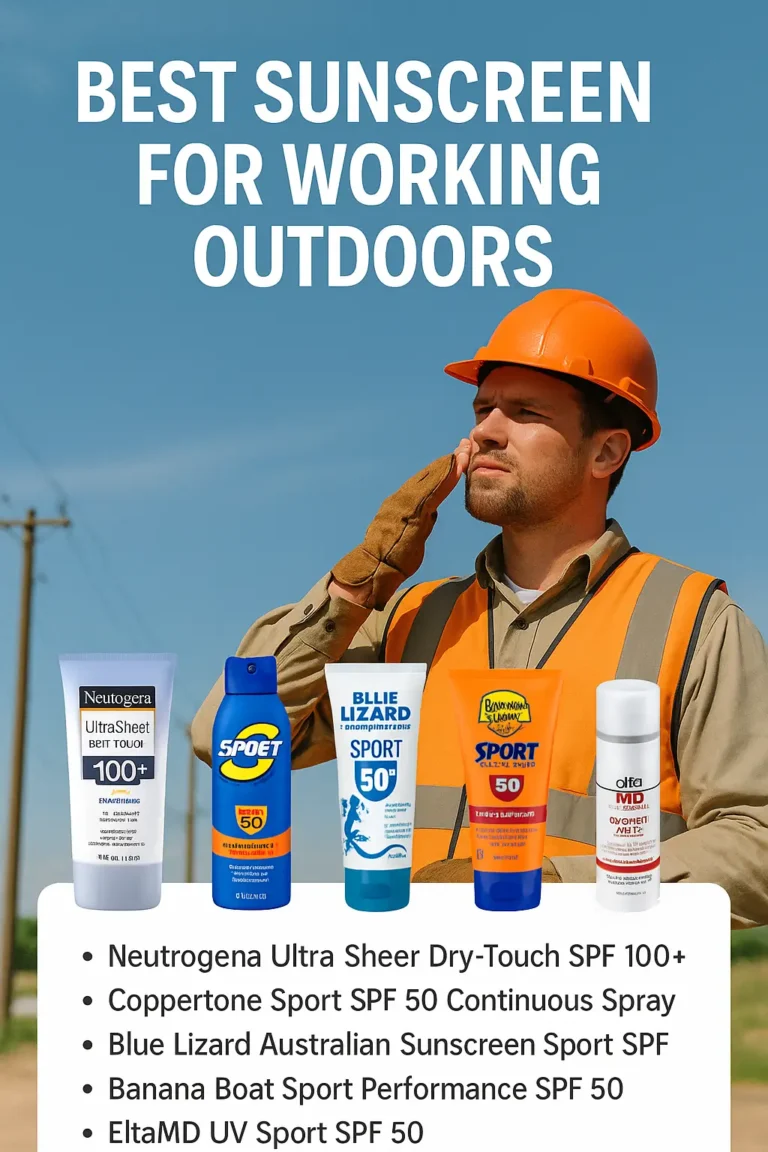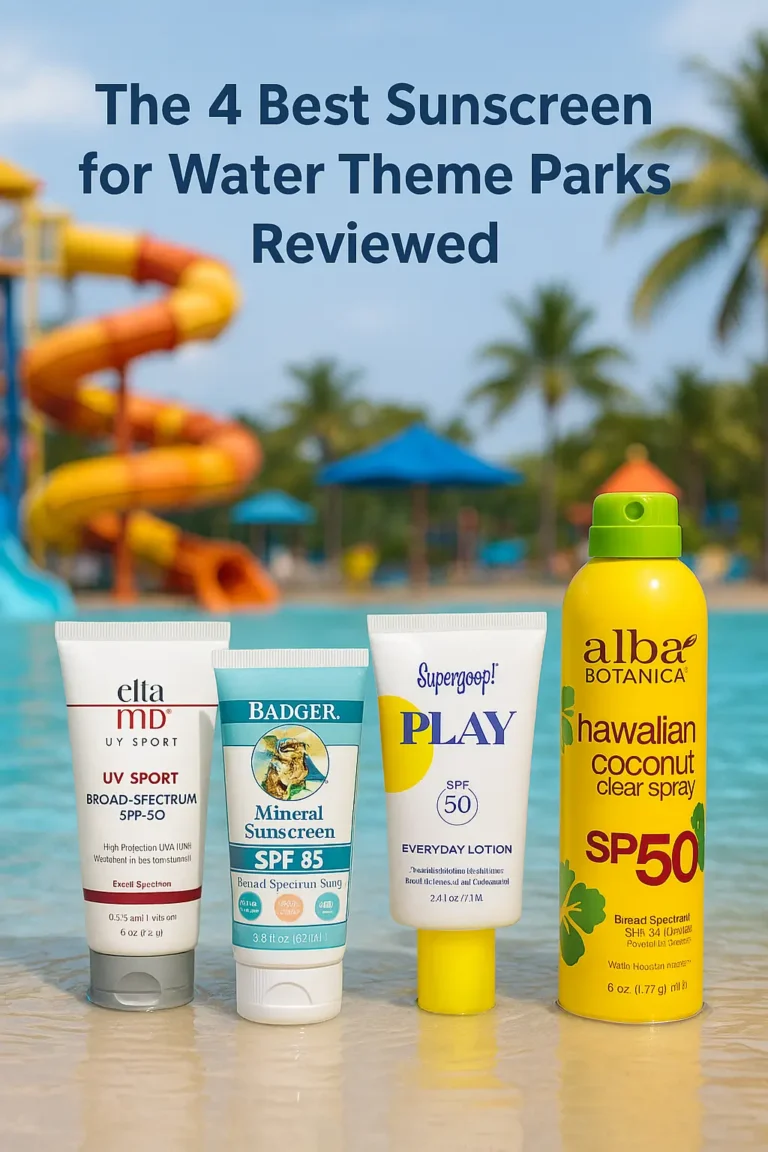The Complete 2025 Guide to The 5 Best Sunscreen for Lupus
Table of Contents
If you’re living with lupus, you already know that sun exposure isn’t just about preventing sunburn—it can trigger serious flare-ups that affect your entire body. Finding the best sunscreen for lupus isn’t just about SPF numbers; it’s about choosing formulations that provide comprehensive protection while being gentle enough for compromised, sensitive skin.
Lupus affects over 1.5 million Americans, and photosensitivity occurs in 40-70% of patients with systemic lupus erythematosus (SLE). This means that even brief sun exposure can trigger skin rashes, joint pain, fatigue, and other systemic symptoms. The stakes are higher than typical sun protection—you need the best sunscreen for lupus that can truly shield you from UV-induced flares.
In this comprehensive guide, we’ll explore everything you need to know about choosing the best sunscreen for lupus, from understanding which ingredients work best for autoimmune conditions to reviewing specific products recommended by dermatologists and lupus specialists. Whether you’re newly diagnosed or looking to upgrade your current sun protection routine, this guide will help you make informed decisions about the best sunscreen for lupus patients.
Understanding Lupus and Photosensitivity: Why Regular Sunscreen Isn’t Enough
The Lupus-Sun Connection
Lupus photosensitivity goes far beyond normal skin sensitivity. When UV light hits lupus-affected skin, it can:
- Trigger inflammatory cascades throughout the body
- Worsen existing skin lesions (malar rash, discoid lesions)
- Cause new autoimmune flares affecting joints, kidneys, and other organs
- Lead to post-inflammatory hyperpigmentation that can last months
- Exacerbate fatigue and systemic symptoms
This is why finding the best sunscreen for lupus requires understanding that you’re not just preventing cosmetic damage—you’re managing a medical condition.
What Makes Lupus Skin Different
Lupus-affected skin has unique characteristics that influence sunscreen choice:
Increased Inflammation: Chronically inflamed skin is more reactive to chemical ingredients and fragrances.
Compromised Barrier Function: The skin’s protective barrier is often weakened, making it more permeable to irritants.
Medication Interactions: Many lupus medications (hydroxychloroquine, methotrexate, steroids) can increase photosensitivity.
Delayed Reactions: Lupus flares from sun exposure can occur hours or even days after exposure, making protection crucial even for brief outings.
Understanding these factors is essential when selecting the best sunscreen for lupus, as your needs differ significantly from general sun protection requirements.
What Makes the Best Sunscreen for Lupus: Essential Criteria
When dermatologists and rheumatologists recommend the best sunscreen for lupus, they look for specific characteristics:
Non-Negotiable Features
Broad-Spectrum Protection: The best sunscreen for lupus must block both UVA (315-400nm) and UVB (280-315nm) rays. UVA rays are particularly problematic for lupus patients as they penetrate deeper and are more likely to trigger flares.
High SPF: Minimum SPF 30, but SPF 50+ is often recommended. The best sunscreen for lupus provides maximum protection since even minimal UV exposure can be problematic.
Physical/Mineral Blockers: Zinc oxide and titanium dioxide are generally better tolerated than chemical filters for sensitive, inflamed skin.
Water Resistance: Essential for maintaining protection during daily activities, sweating, or outdoor exposure.
Lupus-Specific Considerations
Fragrance-Free Formulations: Fragrances can trigger contact dermatitis in already sensitive lupus skin.
Hypoallergenic Ingredients: The best sunscreen for lupus avoids common irritants like parabens, sulfates, and dyes.
Anti-Inflammatory Properties: Some sunscreens include ingredients like niacinamide or ceramides that can help calm inflamed skin.
Non-Comedogenic: Many lupus patients are on medications that affect skin oil production, making clogged pores a concern.
Gentle Preservative Systems: Harsh preservatives can trigger reactions in compromised skin barriers.
Top 5 Best Sunscreens for Lupus: Dermatologist-Recommended Options
After consulting with dermatologists who specialize in autoimmune conditions and reviewing clinical studies on photosensitive patients, here are the best sunscreen options for lupus:
1. EltaMD UV Clear Broad-Spectrum SPF 46 – Best Overall for Lupus

Why it’s the best sunscreen for lupus: EltaMD UV Clear consistently ranks as the top choice among dermatologists treating lupus patients.
Key Features:
- 9% zinc oxide + 7.5% octinoxate for broad-spectrum protection
- Niacinamide (vitamin B3) helps reduce inflammation
- Hyaluronic acid provides hydration without heaviness
- Oil-free, fragrance-free, and paraben-free
- Suitable for post-procedure skin (indicating gentleness)
Pros:
- Specifically formulated for sensitive, post-inflammatory skin
- Lightweight texture that works under makeup
- Contains anti-inflammatory ingredients
- Recommended by lupus specialists nationwide
- No white cast on most skin tones
Cons:
- Higher price point ($44 for 1.7oz)
- Contains octinoxate (some prefer 100% mineral)
- May require reordering online
Best for: Daily facial use, under makeup, patients with frequent flares
Available at Amazon
2. Blue Lizard Sensitive Mineral Sunscreen SPF 50+ – Best Budget Option

Why it’s among the best sunscreens for lupus: Developed by dermatologists specifically for sensitive skin conditions, including autoimmune disorders.
Key Features:
- 10% zinc oxide + 5% titanium dioxide (100% mineral)
- Smart bottle technology changes color in UV light
- Fragrance-free, paraben-free, gluten-free
- Water-resistant for 80 minutes
- Dermatologist-developed formula
Pros:
- More affordable than prescription options
- 100% mineral formula reduces reaction risk
- Smart bottle helps remind users of UV exposure
- Gentle enough for children and sensitive adults
- Available at most pharmacies
Cons:
- Can leave slight white cast initially
- Thicker consistency requires more blending
- Limited availability in some regions
Best for: Body protection, budget-conscious patients, families with lupus
Available at Amazon
3. Vanicream Sunscreen Sport SPF 35 – Best for Daily Activities
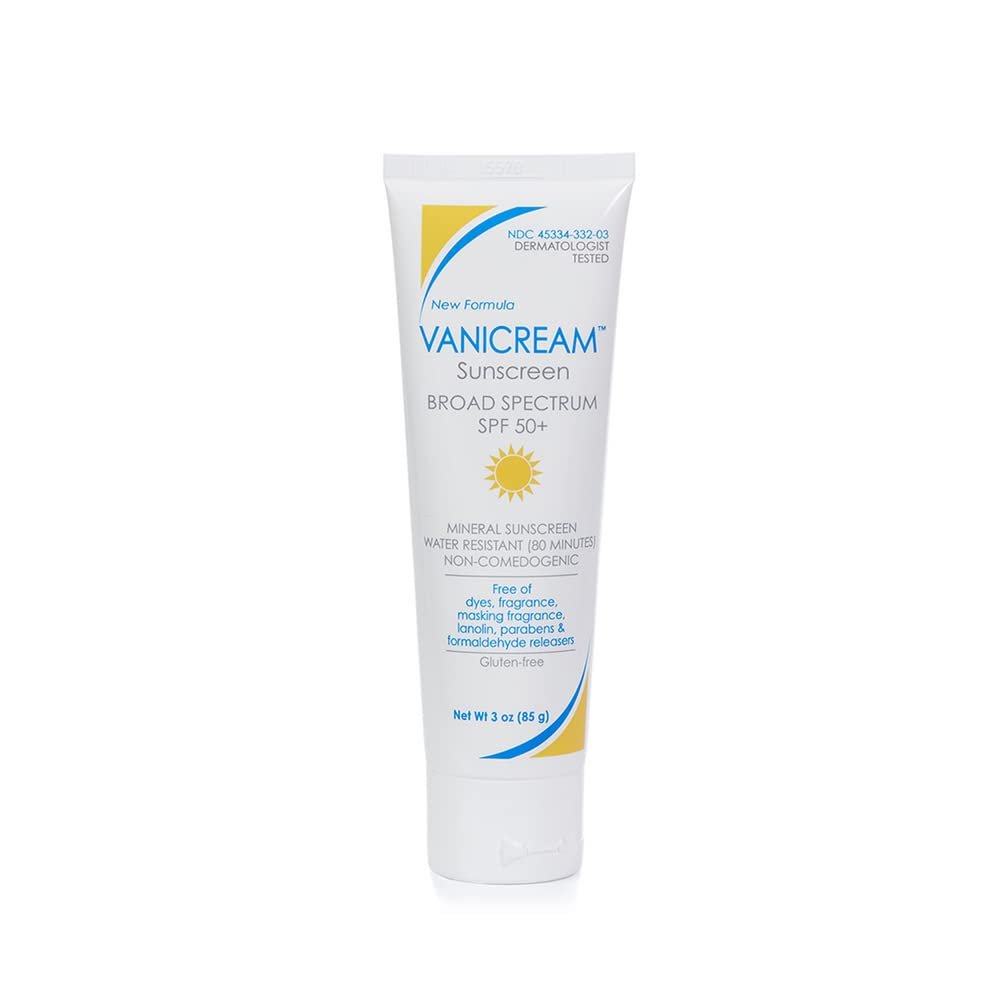
Why it’s the best sunscreen for lupus patients with active lifestyles: Formulated without common chemical irritants while providing reliable protection.
Key Features:
- 7% zinc oxide + 5% titanium dioxide
- Free from dyes, fragrance, parabens, and formaldehyde
- Water and sweat resistant for 80 minutes
- Developed for sensitive skin conditions
- Non-comedogenic formula
Pros:
- Minimal ingredient list reduces reaction risk
- Excellent for exercise and outdoor activities
- Dermatologist-tested on sensitive skin
- Good value for the protection level
- Widely available at pharmacies
Cons:
- Can feel heavy on the face for some users
- White cast more noticeable on darker skin tones
- May require primer under makeup
Best for: Outdoor activities, exercise, patients avoiding chemical filters
Available at Amazon
4. CeraVe Hydrating Mineral Sunscreen SPF 30 Face – Best for Dry Lupus Skin
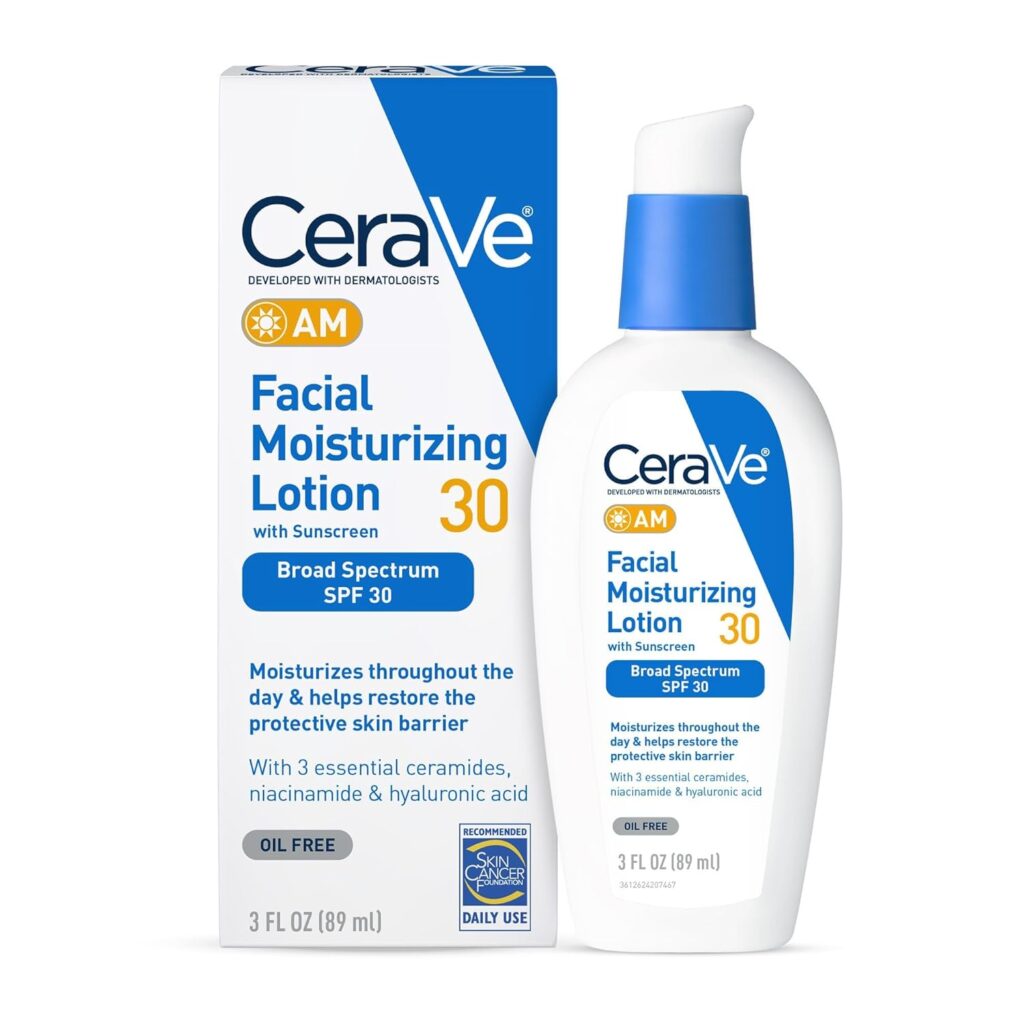
Why it’s the best sunscreen for lupus patients with dry, compromised skin: Combines essential sun protection with barrier-repairing ingredients.
Key Features:
- 13.6% zinc oxide for broad-spectrum protection
- Ceramides help restore skin barrier function
- Hyaluronic acid provides lasting hydration
- Niacinamide reduces inflammation and redness
- Developed with dermatologists
Pros:
- Addresses both protection and skin barrier repair
- Excellent for patients on drying medications
- Contains proven anti-inflammatory ingredients
- Non-greasy formula suitable for daily use
- Good value for the ingredient quality
Cons:
- May be too moisturizing for oily skin types
- Slight white cast that requires blending
- Smaller tube size means frequent repurchasing
Best for: Patients with dry, flaky lupus skin, those on hydroxychloroquine or steroids
Available at Amazon
5. Neutrogena Ultra Sheer Dry-Touch Sunscreen SPF 55 – Best Drugstore Chemical Option
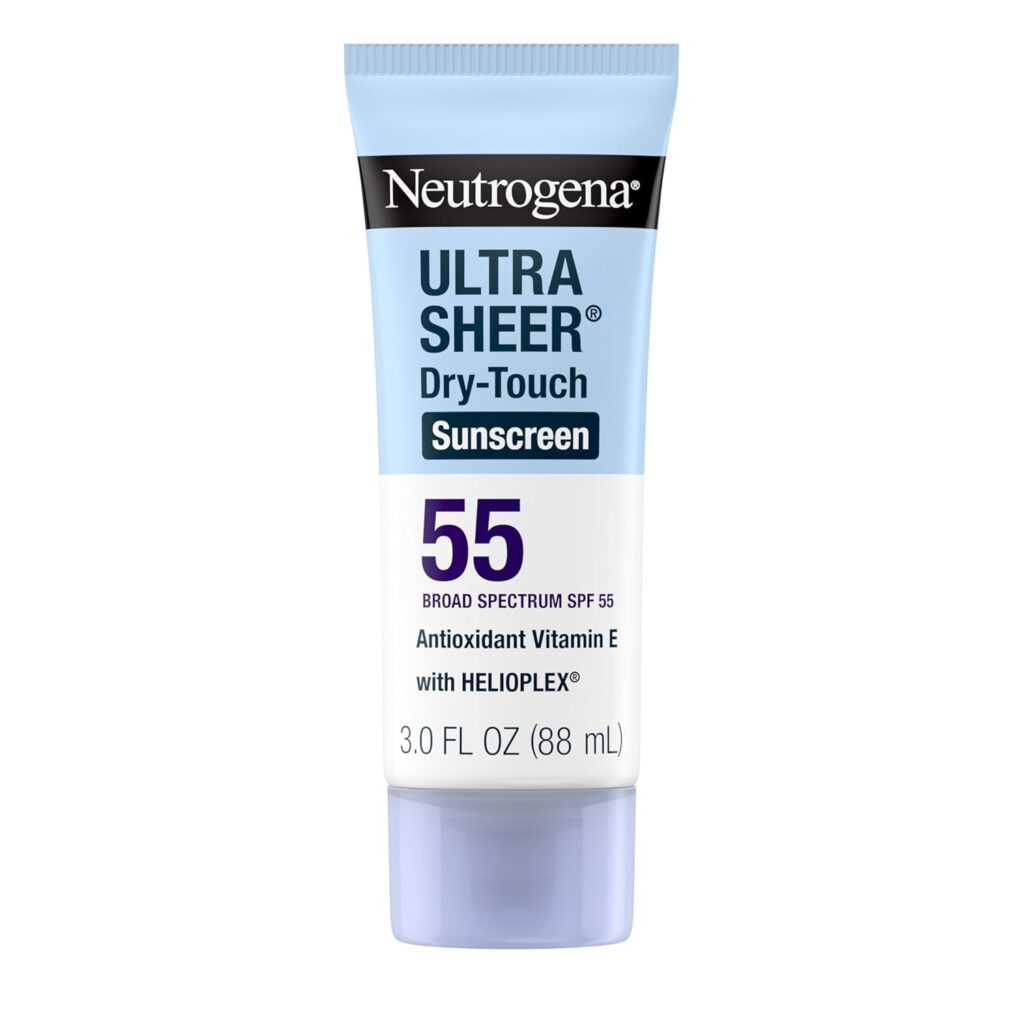
Why it’s the best sunscreen for lupus patients who prefer chemical filters: Proven effective while being widely accessible and affordable.
Key Features:
- Avobenzone + homosalate + octisalate + octocrylene
- Dry-touch technology prevents greasy feel
- Water-resistant for 80 minutes
- Broad-spectrum UVA/UVB protection
- Non-comedogenic formula
Pros:
- Readily available at most stores
- Lightweight, non-greasy application
- No white cast on any skin tone
- Affordable for daily use
- Fast absorption
Cons:
- Chemical filters may irritate very sensitive skin
- Contains potential allergens for some patients
- Not specifically formulated for autoimmune conditions
Best for: Patients who tolerate chemical filters well, budget-conscious options
Mineral vs. Chemical Sunscreens for Lupus: Which Is Better?
When choosing the best sunscreen for lupus, the mineral vs. chemical debate becomes particularly important due to increased skin sensitivity.
Mineral Sunscreens for Lupus
Advantages:
- Immediate protection upon application
- Less likely to cause allergic reactions
- Work by physically blocking UV rays
- Better for inflamed, compromised skin
- Environmentally friendly
Disadvantages:
- Can leave white cast, especially problematic for darker skin tones
- Thicker consistency may feel heavy
- May require more frequent reapplication
- Can be more expensive
Best mineral ingredients for lupus: Zinc oxide (preferred) and titanium dioxide
Chemical Sunscreens for Lupus
Advantages:
- Lightweight, invisible application
- Better cosmetic elegance for daily wear
- Often more water-resistant
- Generally less expensive
Disadvantages:
- Higher potential for allergic reactions
- May sting eyes or irritated skin
- Require 15-20 minutes to become effective
- Some ingredients may worsen photosensitivity
Safest chemical ingredients for lupus: Avobenzone, octinoxate, octisalate (avoid oxybenzone and octinoxate if possible)
The Verdict for Lupus Patients
Most dermatologists recommend mineral sunscreens as the best sunscreen for lupus due to better tolerance in sensitive, inflamed skin. However, the best sunscreen for lupus is ultimately the one you’ll use consistently. If chemical formulas encourage better compliance due to cosmetic preferences, they may be worth trying under medical supervision.
Application Tips: Getting Maximum Protection from Your Lupus Sunscreen
Even the best sunscreen for lupus won’t protect you if it’s not applied correctly. Lupus patients need to be particularly diligent about application techniques:
Proper Application Amount
Face: Use 1/4 teaspoon (about the size of a nickel) for face and neck Body: Use 1 ounce (2 tablespoons) for full body coverage Don’t forget: Ears, lips, scalp (if thinning hair), tops of feet, and between fingers
Timing Matters
- Apply 15-30 minutes before sun exposure
- Reapply every 2 hours minimum
- Reapply immediately after swimming, sweating, or toweling off
- Even on cloudy days—UV rays penetrate clouds
Lupus-Specific Application Tips
Layer with moisturizer: Apply your regular moisturizer first, then sunscreen, to prevent drying Use lip protection: Look for SPF 30+ lip balms with zinc oxide Consider makeup with SPF: As an additional layer, not a replacement Don’t forget indoor protection: Windows block UVB but not UVA rays
Lifestyle Integration: Making Sunscreen Work with Lupus Management
The best sunscreen for lupus must fit seamlessly into your disease management routine:
Medication Considerations
Hydroxychloroquine: May increase photosensitivity initially—use extra protection during the first few months Methotrexate: Increases sun sensitivity significantly—SPF 50+ is essential Corticosteroids: Can thin skin, making gentle mineral formulas preferable Immunosuppressants: Increase skin cancer risk—broad-spectrum protection crucial
Daily Routine Integration
Morning: Apply sunscreen as the last step in your skincare routine Midday: Keep a facial mist sunscreen for touch-ups Evening: Use gentle cleansers to remove sunscreen without irritating skin Travel: Pack travel-sized options and extra supplies
Seasonal Adjustments
Summer: Higher SPF, more frequent reapplication, seek shade during peak hours (10 AM – 4 PM) Winter: Don’t skip sunscreen—snow reflects UV rays, increasing exposure Spring/Fall: Maintain consistent protection—lupus flares can occur with minimal exposure
Special Considerations for Different Types of Lupus
Systemic Lupus Erythematosus (SLE)
The best sunscreen for lupus patients with SLE must provide comprehensive protection since flares can affect multiple organ systems:
- Minimum SPF 50 for daily use
- Broad-spectrum protection is non-negotiable
- Anti-inflammatory ingredients like niacinamide can help manage skin symptoms
- Water-resistant formulas for active lifestyles
Cutaneous Lupus
For patients with primarily skin manifestations:
- Zinc oxide-based formulas work best for inflamed lesions
- Gentle, fragrance-free options reduce irritation risk
- High coverage formulas may be needed for extensive skin involvement
- Tinted options can help camouflage discoloration
Drug-Induced Lupus
Patients with medication-triggered lupus may have:
- Temporary increased photosensitivity requiring higher protection
- Skin that’s more reactive to chemical ingredients
- Need for gentle formulations during flare periods
Sunscreen Ingredients to Avoid with Lupus
When selecting the best sunscreen for lupus, certain ingredients are more likely to cause problems:
Common Irritants
Fragrances and parfum: Can trigger contact dermatitis in sensitive skin PABA and PABA derivatives: Known to cause allergic reactions Alcohol-based formulas: Can dry and irritate already compromised skin Oxybenzone: May cause hormonal disruption and skin reactions Retinyl palmitate: May increase photosensitivity
Preservatives to Watch
Methylisothiazolinone: Common allergen in sensitive individuals Formaldehyde releasers: Can cause contact dermatitis Parabens: While generally safe, may irritate very sensitive skin
Reading Labels for Safety
Look for terms like:
- “Hypoallergenic”
- “Dermatologist tested”
- “Fragrance-free” (not “unscented”)
- “Non-comedogenic”
- “Sensitive skin formula”
Budget-Friendly Options: Best Affordable Sunscreens for Lupus
Managing lupus can be expensive, but you don’t need to compromise on sun protection:
Drugstore Champions
CeraVe Mineral Sunscreen ($15-18): Excellent value with barrier-repairing ingredients Blue Lizard Sensitive ($12-15): Dermatologist-developed at accessible prices Neutrogena Sensitive Skin ($8-12): Good chemical option for those who tolerate it
Money-Saving Tips
Buy in bulk: Purchase multiple tubes when on sale Use manufacturer coupons: Many brands offer online discounts Check insurance: Some plans cover sunscreen with a prescription Generic options: Store brands often use similar formulations at lower costs
DIY Sun Protection Strategies
Protective clothing: UPF-rated clothing can reduce sunscreen needs Seek shade: Reduces the amount of product needed Time outdoor activities: Avoid peak UV hours when possible
When to See a Dermatologist: Beyond Sunscreen
While finding the best sunscreen for lupus is crucial, sometimes professional intervention is needed:
Warning Signs
- Persistent burning or stinging from all sunscreen types
- New or worsening skin lesions despite consistent protection
- Unusual reactions to previously tolerated products
- Signs of skin cancer (new moles, changing lesions)
Professional Options
Prescription sunscreens: Higher concentration actives for severe photosensitivity Compound formulas: Custom blends for specific sensitivities Phototherapy guidance: Professional advice on light exposure management Skin cancer screening: Regular monitoring for lupus patients at higher risk
The Future of Lupus Sun Protection
Research continues into better sun protection options for autoimmune patients:
Emerging Technologies
DNA repair enzymes: Sunscreens that help repair UV damage Antioxidant combinations: Enhanced protection against oxidative stress Microencapsulation: Better delivery of active ingredients Smart formulations: Products that adjust protection based on UV exposure
Research Developments
Studies are ongoing into:
- The optimal SPF for different types of lupus
- Combination therapies with topical immunomodulators
- Personalized sunscreen recommendations based on genetic markers
- Long-term outcomes of different protection strategies
Frequently Asked Questions About Sunscreen and Lupus
Can I get vitamin D if I’m using sunscreen for lupus?
This is a common concern. While sunscreen does reduce vitamin D synthesis, most dermatologists recommend:
- Taking vitamin D supplements instead of risking UV exposure
- Getting vitamin D levels tested regularly
- Discussing supplementation with your rheumatologist
- Never compromising sun protection for vitamin D production
How often should I reapply sunscreen with lupus?
More frequently than the general population:
- Every 2 hours minimum during any sun exposure
- Immediately after swimming, sweating, or toweling off
- Every 1-2 hours if outdoors for extended periods
- Consider setting phone reminders for consistent reapplication
Is water-resistant sunscreen necessary for lupus patients?
Yes, because:
- Lupus patients need consistent protection
- Sweating from medications or heat intolerance can remove sunscreen
- Even brief water exposure requires maintained protection
- Water-resistant formulas provide more reliable coverage
Can I use makeup with SPF instead of dedicated sunscreen?
No, makeup with SPF should only be supplemental because:
- Most people don’t apply enough makeup to get the stated SPF
- Makeup may not provide even coverage
- SPF in makeup is often lower than needed for lupus protection
- Dedicated sunscreen should always be your primary protection
What’s the best sunscreen for lupus rash on the face?
For active facial rashes:
- Choose gentle mineral formulas with zinc oxide
- Look for anti-inflammatory ingredients like niacinamide
- Avoid fragrances and harsh chemicals
- Consider tinted options to help camouflage redness
- Always patch test new products on unaffected skin first
Conclusion: Your Path to Better Sun Protection with Lupus
Finding the best sunscreen for lupus is about more than preventing sunburn—it’s about managing a chronic condition and preventing potentially serious flares. The ideal sunscreen for your lupus will depend on your specific symptoms, skin sensitivity, lifestyle, and budget.
Remember these key points:
- Mineral sunscreens (zinc oxide, titanium dioxide) are generally safer for sensitive lupus skin
- SPF 30 is the minimum, but SPF 50+ is often recommended for lupus patients
- Broad-spectrum protection is non-negotiable for preventing UVA-triggered flares
- Consistent application matters more than the specific brand you choose
- Individual tolerance varies—what works for others may not work for you
The best sunscreen for lupus is ultimately the one that provides adequate protection while being gentle enough for daily use and cosmetically acceptable enough that you’ll use it consistently. Don’t be afraid to try different options under your doctor’s guidance until you find your perfect match.
Living with lupus presents unique challenges, but with the right sun protection strategy, you can maintain an active, fulfilling lifestyle while keeping your condition well-managed. Start with the recommendations in this guide, consult with your healthcare team, and remember that good sun protection is one of the most effective tools in your lupus management arsenal.
Your skin—and your overall health—will thank you for taking the time to find the best sunscreen for lupus that meets your individual needs.
Author’s Top Picks
- EltaMD UV Clear vs UV Daily
- The 5 Best Sunscreen for Working Outdoors : My Top Picks
- The 5 Best Sunscreen After Fraxel Tested (2025)
- The 5 Best Sunscreen for Scars in 2025: Reviews & Where to Buy

